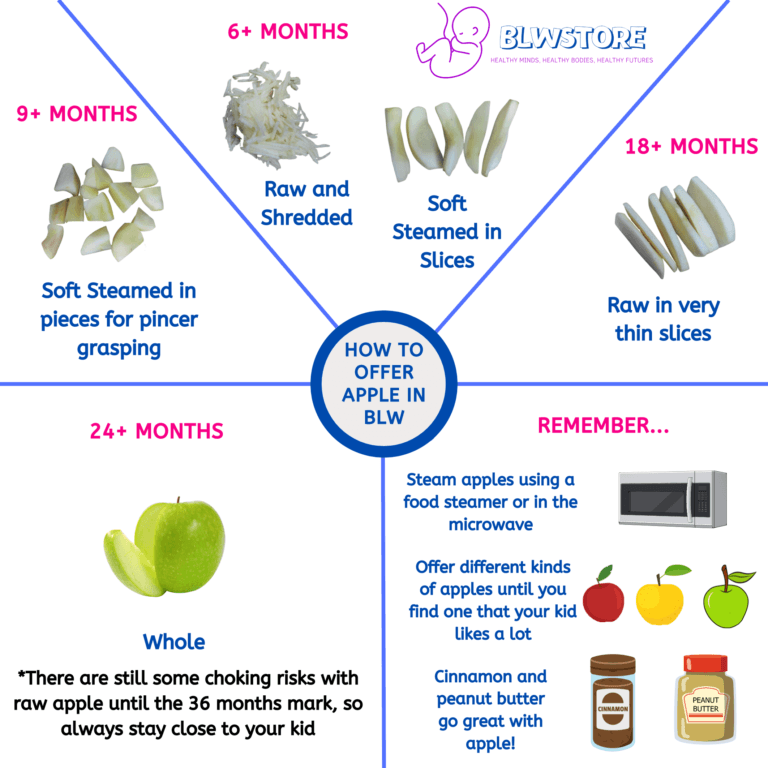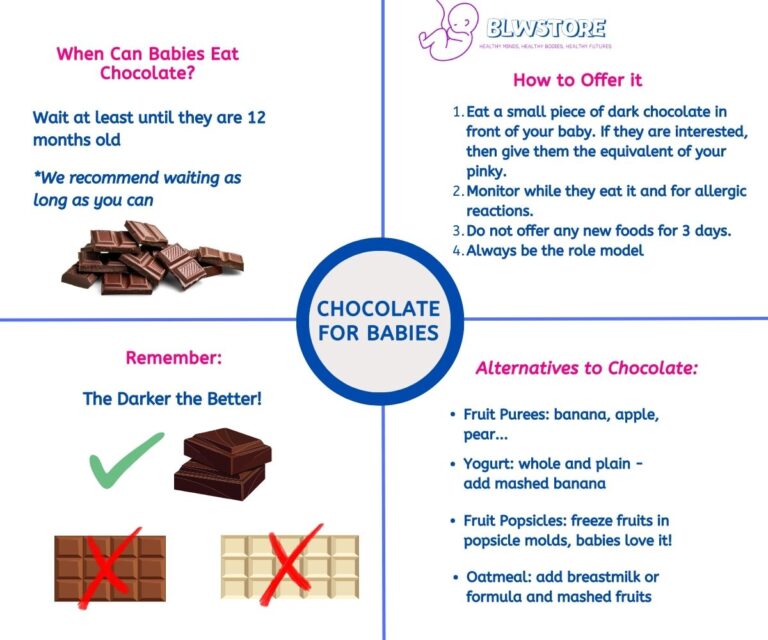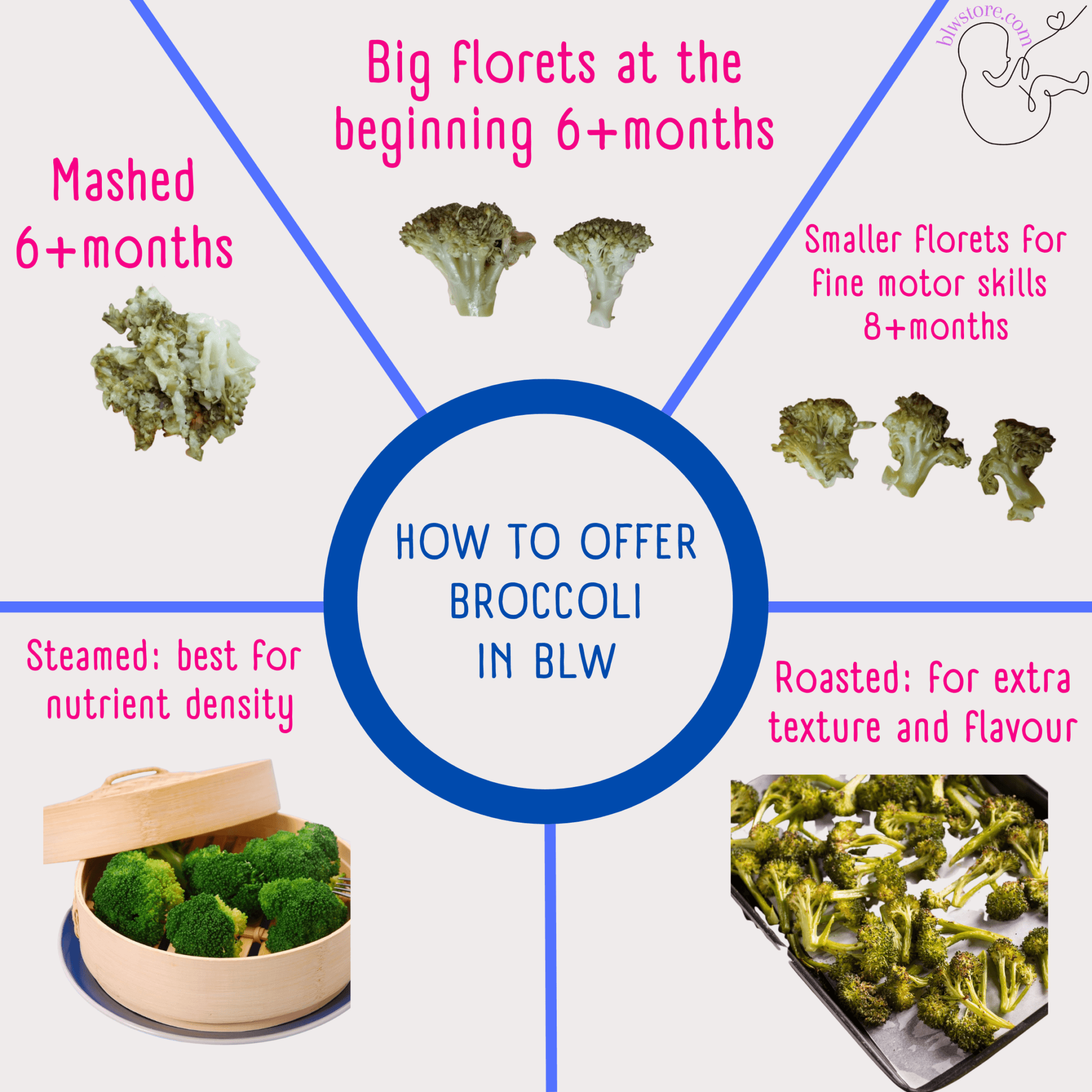
Discover the many benefits of introducing broccoli into your baby’s diet with our comprehensive guide to baby-led weaning broccoli. In this article, you’ll learn:
- Why broccoli is an excellent choice for baby-led weaning
- The best ways to prepare and serve broccoli to your baby
- Nutritional benefits of including broccoli in your baby’s diet
- Storage and reheating tips for broccoli
- Answers to frequently asked questions about baby led weaning broccoli
Let’s get after it!
Key takeaways
- Broccoli is an easy-to-grasp, nutrient-dense food that supports healthy growth and development
- The best way to cook broccoli for baby-led weaning is by steaming it, preserving its nutrients and natural flavors
- Broccoli can be served in various forms, such as large florets, small florets, or mashed, to suit your baby’s developmental stage
- Store raw broccoli in a sealed container or bag in the refrigerator, and cooked broccoli in an airtight container for up to four days
- Always introduce new foods gradually and monitor your baby for potential allergic reactions
How to cut broccoli for baby-led weaning
Big Florets. Steamed or Roasted.
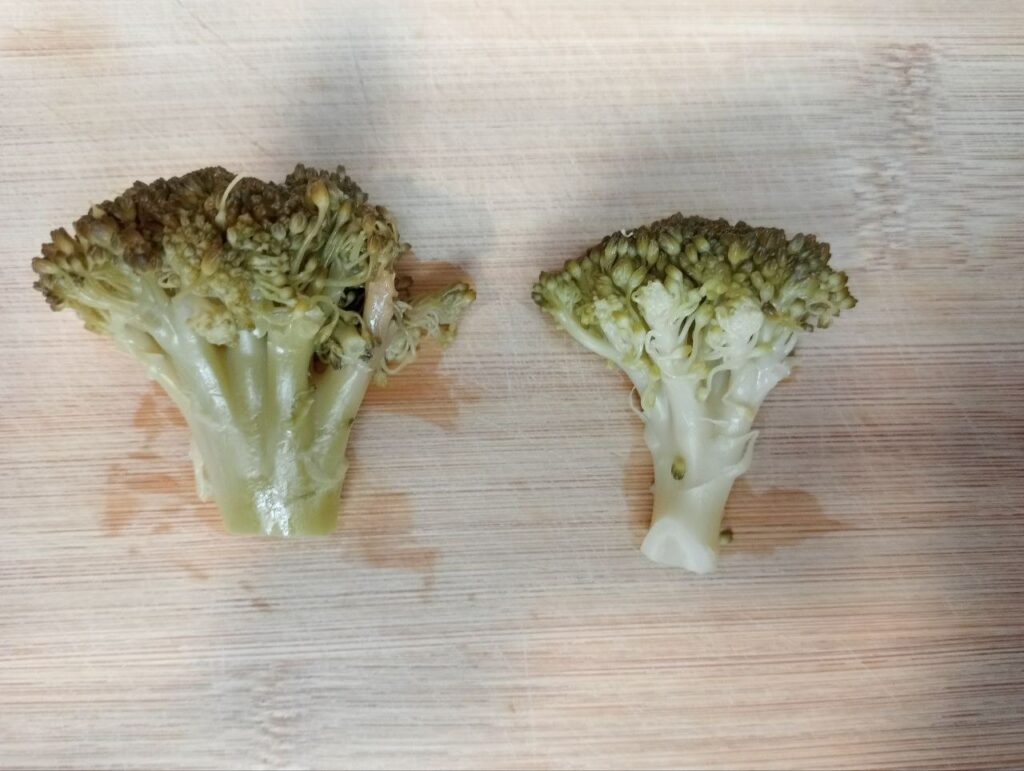
This is the best way to introduce and cut broccoli for the first time. Steamed is the best way, as it retains all its nutrients and natural flavor.
If your baby rejects it (which was the case for Pablo), then try adding some additional spices. But treat spices as new foods too, i.e. wait about 2 days after introducing a new spice.
You can also try roasting it to give it a crunchy point, although you must check that it is tender.
Mashed. Steamed or Roasted

Another great option to introduce it for the first time if you feel more confident offering it this way.
Mashed also allows you to mix it with other foods, but keep in mind that it is best to wait until the food is fully introduced.
Small Florets

As with the banana, we can cut and offer smaller pieces of broccoli in the form of a bunch to promote the development of fine motor skills, once your baby is able to pincer grasp.
Why is broccoli a great BLW food?
It is easy to grasp and chew.
Broccoli is a food that is easy for babies to pick up, handle and put in their mouths.
It can be easily chewed by baby’s gums.
Therefore, it is firm enough to be picked up but soft enough to be chewed, which is perfect for Baby led Weaning.
Broccoli is a Nutrient-dense food
It is packed with essential nutrients and vitamins such as:
- Fiber
- Vitamins C, K and B6.
- Potassium, magnesium and calcium.
- Iron, zinc, and folate.
And many others.
It is low in fat
Making it an ideal food for babies who are trying to maintain a healthy weight.
Can be prepared in a variety of ways
Broccoli can be steamed, boiled, roasted, or even pureed into a delicious soup or sauce. You can easily try different ways until you find your baby’s favorite.
Broccoli is versatile
It can be added to other dishes to make a complete meal:
- Broccoli and sweet potato soup
- Broccoli and cheese quesadilla
- Broccoli and white bean bake
- Broccoli and cauliflower mash
- Broccoli, apple, and cheese puree
- Pureed broccoli and potato
- Broccoli and Pasta Bake
When should you introduce broccoli to your baby?
The age to start introducing solids is 6 months. This may change slightly depending on your baby’s developmental level.
How should broccoli be cooked for baby-led weaning?
Let’s take a look at their different ways of cooking broccoli for baby led weaning:
Best way: Steamed

Steaming broccoli helps preserve its nutrients best, and it’s easy to cut into small pieces to suit your baby’s biting stage. It is also the easiest way to cook, provided you have a quality steamer. Finally, your baby will taste the natural flavour of the food, which is always recommended.
If you are interested, you can check our buyer’s guide on the best baby food steamers.
Second best: Roasted
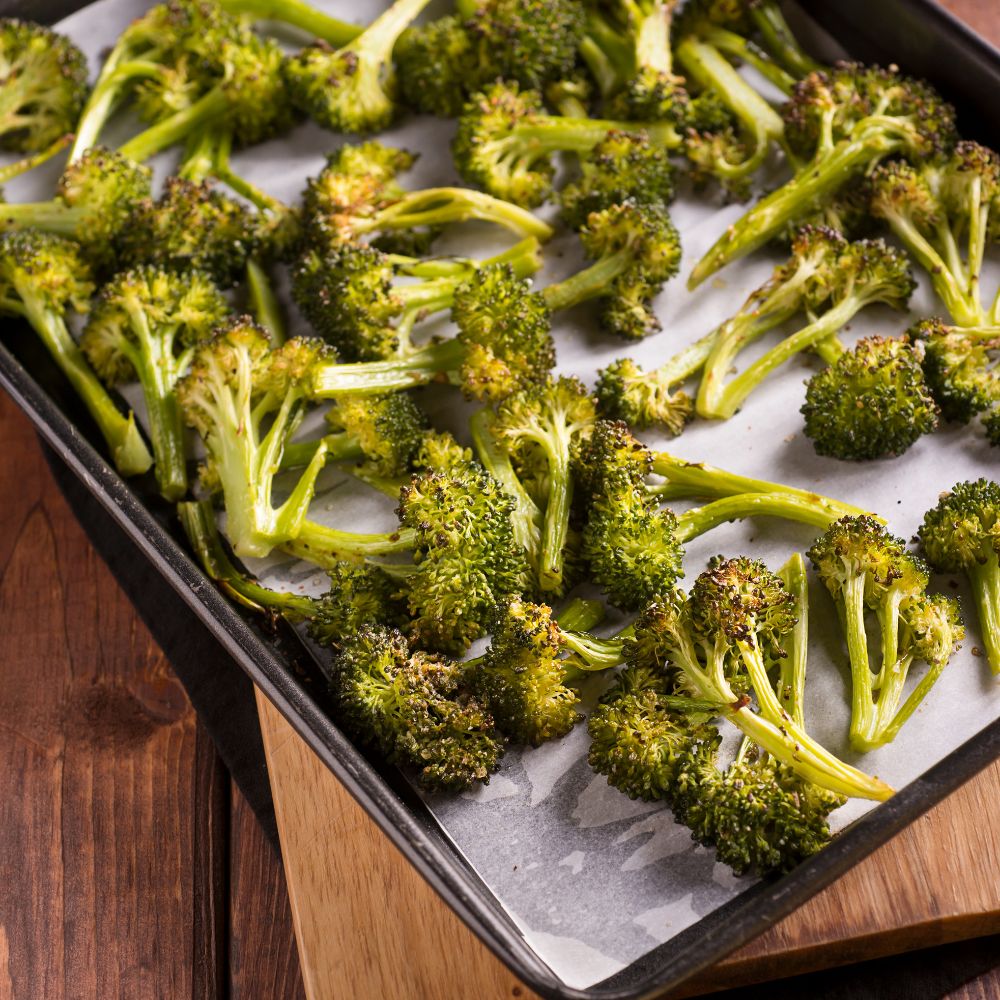
Your baby will enjoy this vegetable more if you grill it first.
Add some olive oil and bake or air-fry it.
This cooking method is fantastic since it preserves the food’s nutritional value.
Third best: Sauteed

Sautéing it is another way to cook it while preserving nutrients. A little extra virgin olive oil if possible, and sauté it until tender.
Better don’t: Boiled

Steaming or roasting broccoli and other cruciferous veggies is the best way to go. Boiling them will cause the loss of water-soluble vitamins like vitamin C and folate, as well as many glucosinolate compounds, which are also water-soluble. So be sure to try other methods instead of boiling.
What does broccoli provide for your baby?
- It is high in essential vitamins and minerals, such as vitamin A, C, K, folate, and potassium, and is also an excellent source of dietary fiber.
- Broccoli is packed with antioxidants that can help protect cells from damage caused by free radicals, and the phytonutrients it contains have anti-inflammatory properties.
- The calcium in broccoli can help strengthen bones, while its vitamin C content helps support growth and development. (Reminder: no boiling!)
- Eating broccoli regularly may help reduce the risk of certain chronic diseases and boost the immune system.
- The soluble fiber in broccoli can aid digestion and help keep your baby’s digestive system healthy.
- The iron in broccoli can help to prevent anemia and keep your baby’s energy levels up. Iron-rich foods are specially important when starting complementary feeding.
What is the best way to store broccoli?
Raw
Raw broccoli should be stored in a sealed container or bag in the refrigerator.
It is best to consume broccoli within five days of purchase, and storing it in the coldest part of the refrigerator will help retain its freshness for longer.
If you plan on storing it for longer than five days, it is best to blanch the broccoli first in boiling water for 2 minutes, then shock it in an ice bath to stop the cooking process. This will help preserve the bright green color and crisp texture.
After blanching and shocking, dry the broccoli thoroughly and store it in a sealed container or bag in the refrigerator.
Cooked
Cooked broccoli should be stored in an airtight container or wrapped in plastic wrap and refrigerated.
Broccoli may be preserved in the refrigerator for up to four days after cooking. Make sure the broccoli has completely cooled before storing it.
When reheating the broccoli, avoid microwaving it since it will turn mushy. Instead, reheat the broccoli in a pan with a little oil or butter, or steam it until tender.
Baby Led Weaning broccoli FAQ
1. How do you steam frozen broccoli for babies?
Steaming frozen broccoli for newborns is a quick and easy method to introduce a nutritious vegetable to them.
- To begin, you’ll need a lidded pot and a steamer basket that fits inside.
- Fill the kettle halfway with water and bring it to a boil.
- Immerse the frozen broccoli in the steamer basket, ensuring sure the pieces are small enough for your child to handle, and place it in the boiling water.
- Cover the kettle and steam the broccoli for 5 minutes, or until fork-tender. You may flavor the broccoli by sprinkling it with garlic powder before steaming it.
- When the broccoli is done, carefully remove the steamer basket and place it on a platter.
- Allow it to cool before presenting it to your baby, and be sure to chop any large chunks into smaller, bite-sized pieces.
To make the process easier, you might want to use a baby food steamer.
2. Is broccoli hard to digest for babies?
Generally speaking, broccoli is not difficult to digest for babies. However, it may depend on the age and stage of development of the baby.
Breastfed infants may find it easier to digest than formula-fed babies due to the natural enzymes found in breastmilk that help break down the fibrous nature of broccoli.
But you shouldn’t worry about that. Simply introduce broccoli in very small quantities and well cooked. If you find that your baby has a tummy ache or more gas than usual, try other foods first.
Squeezing a little lemon juice on broccoli can help with digestion.
3. Is broccoli good for babies everyday?
For newborns, eating broccoli daily has many positive health effects, but it’s vital to remember that a balanced diet is necessary at any age.
In order to provide your infant the whole range of vitamins and minerals, it’s vital to introduce different foods even if you opt to give him or her broccoli every day. Your kid will benefit as well since he will become accustomed to new tastes and textures.
4. Is broccoli a high allergy food for babies?
Broccoli is not a food that causes severe allergies in infants. In actuality, broccoli is typically regarded as being quite safe for infants and young children.
To make sure your kid doesn’t have any negative responses, it’s vital to introduce broccoli gradually and in modest amounts, just like you would with any other meal.
5. Is it better to boil or steam broccoli for babies?
Steaming, as mentioned above, is always better as it preserves the nutrients and natural flavor of the food much better.
6. Can you freeze cooked broccoli?
Broccoli that has been cooked can be frozen.
You need first blanch the broccoli before doing this:
- Broccoli is blanched by briefly heating it in water before plunging it into ice water. The color and texture of the broccoli are preserved by this technique.
- After the broccoli has been blanched, let it cool fully before putting it in a freezer bag or airtight container.
- When ready to use, let the broccoli defrost overnight in the refrigerator.

Roasted Broccoli with Lemon, Oregano, and Thyme for Babies
Equipment
- 1 baking sheet
- 1 mixing bowl
- 1 spatula
Ingredients
- 1 small head of broccoli
- 1 tbsp olive oil extra virgin if possible
- 1/4 tbsp dried oregano
- 1/4 tbsp dried thyme
- 1/4 tbsp black pepper
- 1/2 lemon Juiced
Instructions
- Preheat your oven to 400°F (200°C).
- Cut the broccoli into small florets, removing any tough stems or leaves.In a mixing bowl, combine the broccoli florets, olive oil, oregano, thyme, and black pepper. Toss to coat the broccoli evenly.
- Transfer the broccoli to a baking sheet and spread it out into a single layer.
- Roast the broccoli in the preheated oven for 10-15 minutes, or until it's tender and slightly browned.
- Squeeze half a lemon over the roasted broccoli and toss to coat.
Conclusion
In conclusion, broccoli is a great first food for babies between 6-8 months of age.
Whether served as steamed whole broccoli, precut florets, or small finger-size sticks, broccoli is a good choice for parents who are introducing solid foods.
As with any new food items, it’s essential to follow the American Academy of Pediatrics guidelines to reduce the risk of choking hazards.
Always wash broccoli and remove tough outer layers before serving it to your baby.
For younger babies, cut broccoli into larger pieces of food, and for older babies, offer smaller pieces to encourage self-feeding and the use of the pincer grasp.
Broccoli can also be used in easy recipes for baby food, nutritious family side dishes, and even as a delicious topping on a slice of bread with a little bit of butter.
So don’t hesitate, try serving broccoli to your baby, and enjoy the many benefits of this nutritious food for the whole family.
We’re Maria and Alberto, a married couple and educators who are nutrition enthusiasts. Even before we had kids, we were already crazy about nutrition.
We’d read scientific articles, watch videos from nutritionists, and spend hours listening to nutrition podcasts.
Today, we continue doing this, but in a different way, as we’ve learned to sift through the noise and trends. Nutrition, like any other field of knowledge, the more you read and learn, the more you develop a comprehensive understanding of reality, and that’s what has happened to us.
Before having our first child, we focused on learning everything we could about child nutrition, using the same techniques we had already employed, backed by our extensive knowledge in nutrition.
Our mission is to help other parents with their children’s nutrition, to help them become the best versions of themselves.
If we are what we eat and drink, which is absolutely true, let’s do it right!



